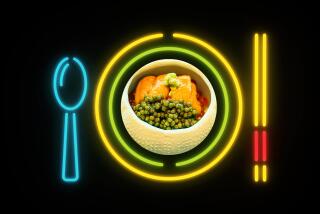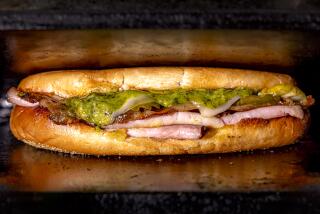Chef David LeFevre’s sizzling secrets to making a great steak

With a very hot cast-iron skillet, chef David LeFevre demonstrates how to grill a rib-eye steak.
- Share via
Chef David LeFevre is looking for the right pan. He settles on a heavy cast-iron skillet, which he sets on the stove over high heat. “You want a hot, hot pan,” he says.
Perhaps more well-known for his talent with fish — LeFevre is chef and partner at Manhattan Beach’s popular spots M.B. Post and Fishing With Dynamite — LeFevre has just opened Arthur J, a new steakhouse also in Manhattan Beach. Today, he’s here to talk steak.
“There are three things you want in a good steak: fat, flavor and tenderness,” he says as he places a prime rib-eye on the counter. It’s one of three steaks he’s brought to The Times Test Kitchen, including a dry-aged porterhouse and a skirt steak. He explains the different cuts and what to look for with each, along with how to coax out the best flavor. The rib-eye is the one he’ll cook today — the boneless 16-ounce cut is almost 2 inches thick and beautifully marbled. “Thickness is very important. The thicker it is, the more color you can get on the steak without overcooking it.
RECIPE: David LeFevre’s rib-eye steak
“A couple things to do before cooking. First, have the steak at room temperature. Second, make sure it’s dry.” He blots the steak with a paper towel, before seasoning the steak with salt and pepper.
“You need more salt to compensate for all the meat in the center.” The two biggest mistakes people make when cooking steak, he stresses, are that they underseason and they don’t let the meat rest long enough before serving.
LeFevre checks the pan, letting it heat up a few more minutes before beginning to cook. “Have the windows open for this one,” he says, smiling.
When the pan is hot, LeFevre adds oil, then tilts the pan before adding the steak so the oil won’t splatter. “Don’t move the steak,” he cautions. It’s important to leave the meat alone so it can form a flavorful crust.
Instead, he moves the pan, tilting it gently so the oil moves around and under the steak as it cooks. “Basically, you want to get a hot enough sear so that the surface caramelizes without overcooking the meat.
“See the crust? It’s a nice brown — that’s the color you’re looking for. Color is flavor. The meat and fat are caramelizing.”
SIGN UP for the free In the Kitchen newsletter >>
LeFevre cooks the steak for only a few more minutes, watching as the heat slowly transforms the meat. “It starts to sweat when it’s close to being done — it will glisten from the moisture in the meat. That’s how I know it’s gone from being rare.”
He touches the steak, checking to see how quickly the meat springs back. Then he checks with a thermometer, pushing it into the thickest part of the meat. “This is the best way for a home cook to check for doneness.” The steak registers at 118 degrees, but the temperature will continue to rise, or “carry over,” the next few minutes as the meat rests.
LeFevre moves the steak to a rack for several minutes while he prepares a creamy horseradish sauce. Then he places the steak on a wooden cutting board, and brushes it lightly with shallot butter. He slices the steak crosswise into strips; slicing against the grain makes each bite more tender.
The chef then serves the steak on the cutting board next to a dipping bowl of the sauce, sprinkling a pinch of fleur de sel over the meat for a little added texture and a squeeze of lemon to cut the richness of the meat. It’s a steakhouse-quality meal you can make at home.
::
A closer look at skirt, rib-eye and porterhouse steaks
SKIRT STEAK
This is the boneless trim diaphragm, from the plate cut of beef. It’s an incredibly flavorful piece of meat with high fat content and an interesting grain. The trick with cooking it is to use high heat — grill or sauté — as the steak is not very thick. Before serving, slice it against the grain so the steak is tender for your guests.
RIB-EYE STEAK
This is from the rib primal cut of beef — the rib roast above the plate. There are two parts to a rib-eye: the rib cap (the outer end of the steak) and the rib center. When choosing rib-eye, look for good marbling. This is another steak that benefits from high heat and benefits most from grilling, sautéing or roasting.
PORTERHOUSE
Often called the “king of steaks,” the porterhouse comes from a cut on the short loin where the tenderloin and strip loin (New York steak) come together. It’s essentially two steaks — a strip and tenderloin, or filet mignon — in one, separated by a bone. For the steak to be called a porterhouse, the tenderloin portion must have a diameter of at least 11/2 inches.
More to Read
Get our Cooking newsletter.
Your roundup of inspiring recipes and kitchen tricks.
You may occasionally receive promotional content from the Los Angeles Times.







